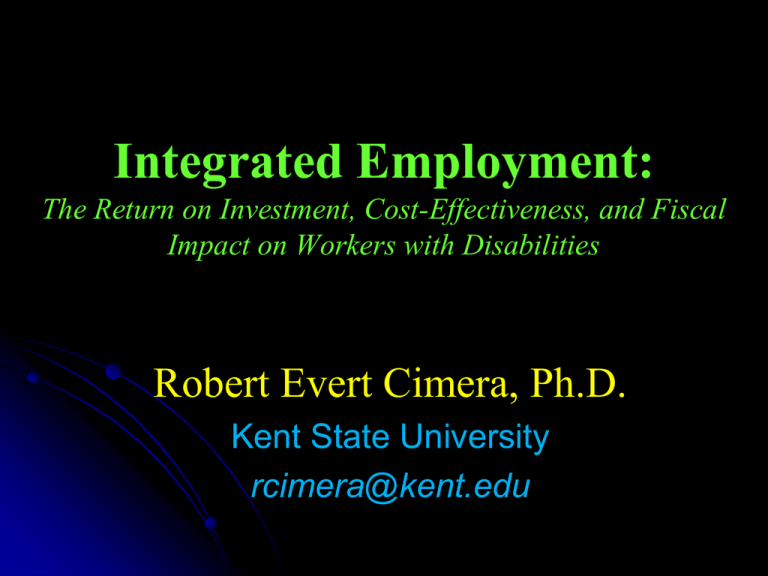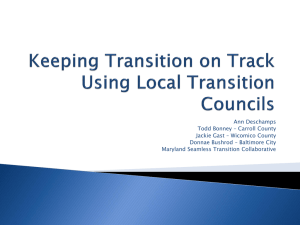The Economics of Supported Employment: What We
advertisement

Integrated Employment: The Return on Investment, Cost-Effectiveness, and Fiscal Impact on Workers with Disabilities Robert Evert Cimera, Ph.D. Kent State University rcimera@kent.edu Disclaimer I am by no means suggesting that money is the bottom line for any policy decisions. Disclaimer I am by no means suggesting that money is the bottom line for any policy decisions. However… “Economics is the language of politicians and policymakers….” Question #1: “Should People Go Into Supported Employment?” Question #1: “Should People Go Into Supported Employment?” Benefits: Wages Earned in the Community Costs: Forgone Wages from a Workshop Taxes Paid Lost Governmental Subsidies Question #1: “Should People Go Into Supported Employment?” Individuals with Intellectual Disabilities (n=64,692) Benefit-Cost Ratio = 4.20 Source: Cimera (2010b) Question #1: “Should People Go Into Supported Employment?” Individuals with Intellectual Disabilities (n=64,692) Benefit-Cost Ratio = 4.20 Individuals with Autism Spectrum Disorder (n=19,436) Benefit-Cost Ratio = 5.28 Source: Cimera & Burgess (2011) Question #1: “Should People Go Into Supported Employment?” Supported Employment was cost-efficient from the worker’s perspective All disabilities, Secondary conditions, and All States. Source: Cimera (in press) Question #1: “Should People Go Into Supported Employment?” Yes…. Question #2: “Which is More CostEffective: SE or SW?” Supported v. Sheltered Employment Cumulative Costs SE: $18,813 SW: $46,855 Source: Cimera (2011b) Supported v. Sheltered Employment Cumulative Costs SE: $18,813 SW: $46,855 Cost per Hr. Worked SE: $11.88 SW: $17.12 Source: Cimera (2011b) Supported v. Sheltered Employment Cumulative Costs SE: $18,813 SW: $46,855 Cost per Hr. Worked SE: $11.88 SW: $17.12 Cost per Dollar Earned SE: $2.02 SW: $9.39 Source: Cimera (2011b) Percent of Total Program Costs Supported Employees 14% 12% 10% Supported Employees 8% 6% 4% 2% 0% 1 2 3 4 5 6 7 Fiscal Quarters 8 9 10 11 12 Source: Cimera (2008) Percent of Total Program Costs 14% 12% 10% Sheltered Employees 8% Supported Employees 6% 4% 2% 0% 1 2 3 4 5 6 7 Fiscal Quarters 8 9 10 11 12 Source: Cimera (2008) Question #2: “Which is More CostEffective: SE or SW?” It appears, SE is more cost-effective. Source: Cimera (in press) Question #3: “Is SE a Good Investment for Taxpayers?” Question #3: “Is SE a Good Investment for Taxpayers?” Benefits (per month): Alternative Program Savings………$731.64 Taxes Paid………………………….. $ 70.84 Reduction in Subsidies…………….($ 6.83) Costs (per month): $795.65 $544.31 Cost of SE Services……………….. $394.31 Tax Credits to Employers…………. $150.00 231,204 Supported Employees (2002-2007) Source: Cimera (2010a) Question #3: “Is SE a Good Investment for Taxpayers?” Benefit-Cost Ratio = 1.46 Mental Illnesses = 1.68 Physical Disabilities = 1.66 Autism Spectrum Disorder = 1.62 Sensory Impairments = 1.35 Intellectual Disabilities = 1.20 Traumatic Brain Injuries = 1.17 Source: Cimera (2009) Question #3: “Is SE a Good Investment for Taxpayers?” Yes…regardless of disability or number of disabilities (but not in all States). Source: Cimera (2009) Question #4: “How Do We Make SE More Effective and Efficient?” The Utilization of “Natural Supports” SE with “Natural Supports” Average Cost = $5,063 Employment Cycle = 6.04 fiscal quarters Cost per Quarter = $838 SE Statewide Average Cost = $8,212 Employment Cycle = 3.36 fiscal quarters Cost per Quarter = $2,444 Source: Cimera (2007) The Utilization of “Natural Supports” SE with “Natural Supports” Reduced costs by 57.6% (from 2001 to 2005) Nearly an 80% increase in length of employment. Source: Cimera (2007) Community-Based Transition Services In-School Community-Based Cost of Services = $1,551 Cost of Services = $1,020 Months Employed = 4.70 Months Employed = 8.10 Source: Cimera (2010c) Sheltered Workshops Prior to SE No Sheltered Workshop Yes Sheltered Workshop Wkly Earnings: $137.20 Wkly Earnings: $118.55 Cost (sample): $4,543* Cost (sample): $7,895 Cost (employed): $5,399* Cost (employed): $8,659 9,808 Individuals with Intellectual Impairments Source: Cimera (2011a) Thank You! Robert Evert Cimera, Ph.D. Kent State University, USA RCIMERA@KENT.EDU References Cimera, R.E. (2007). Utilizing natural supports to reduce the costs of supported employment. Research and Practice for Persons with Severe Disabilities, 32(3), 1-6. Cimera, R.E. (2008). The cost-trends of supported versus sheltered employment. Journal of Vocational Rehabilitation, 28, 15-20. Cimera, R.E. (2009). Supported employment’s cost-efficiency to taxpayers: 2002 to 2007. Research and Practice for Persons with Severe Disabilities, 34, 13-20. Cimera, R.E. (2010a). The national cost-efficiency of supported employees with intellectual disabilities: 2002 to 2007. American Journal on Intellectual and Developmental Disabilities, 115, 19-29. Cimera, R.E. (2010b). The national cost-efficiency of supported employees with intellectual disabilities: The worker’s perspective. Journal of Vocational Rehabilitation, 33, 123-131. Cimera, R.E. (2010c). Can community-based high school transition programs improve the cost-efficiency of supported employment? Career Development for Exceptional Individuals, 33(1) 4-12. Cimera, R.E. (2011a). Does being in sheltered workshops improve the employment outcomes of supported employees with intellectual disabilities? Journal of Vocational Rehabilitation, 35, 21-28. Cimera, R. E. (2011b). Supported versus sheltered employment: Cumulative costs, hours worked, and wages earned. Journal of Vocational Rehabilitation, 35, 85-92. Cimera, R.E. (in press). The Economics of Supported Employment: What New Data Tell Us. Journal of Vocational Rehabilitation. Cimera, R.E. & Burgess, S. (2011). Do adults with autism benefit monetarily from working in their communities? Journal of Vocational Rehabilitation, 34, 173-180






